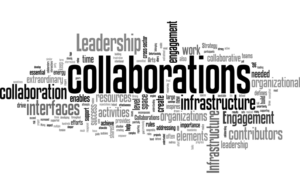Many of us regularly choose to enthusiastically participate in groups outside of our core family and friends. Sports teams, religious organizations, professional societies, and hobby groups are just some examples where you can find enthusiastic, engaged supporters. Those of us involved in organizational collaborations can learn from what makes these groups work. We’ve all been there: collaborations where meetings become a burden, participation is low, and eventually attendance drops off. What is it that keeps participants engaged? We’ve asked that question often in our work here at Strategy Arts. We see three factors that are essential drivers of engaged participation; motivation, community, and support.
Attention to all three of these is needed to drive participant engagement. The specifics are different for each group and situation, but all three are necessary. In hobby groups, for example, the motivation may be to learn more about the hobby. The community is a group of people who share interests. The supports are the participants who schedule meetings and find venues, and others that provide one-on-one skill mentoring. These same three factors apply in professional collaborations with an additional level of complexity. They require considering engagement at two levels; the organizations participating and the individual participants from those organizations.
Motivation Sparks Engagement
In collaborative efforts motivation is usually about achieving something greater together than can be achieved separately. At an organizational level, motivational drivers may be organizational learning, increased effectiveness of existing programs or new programs that fill identified gaps. At an individual level, it may be the opportunity to participate in an exciting new endeavor, to grow professional contacts, or to contribute more to important organizational goals. Understanding and devising ways to satisfy motivational drivers is important to the success of collaborations of all sizes. We’ve found that early collaborative action is an important spark. Finding low hanging opportunities that enable those participating to work together and achieve some level of success early builds the foundation for sustained motivation.
Community Nurtures Engagement
Resilient collaborative efforts build a sense of community among participants. At an organizational level this is a strong sense of trust between organizations and comfortable professional relationships between organizational leadership. For individuals it is the “feeling” of belonging and of being part of the team. Building community requires different sets of activities at the organizational and individual levels. At the organizational level, regular communications on collaborative activities, clear governance, and periodic meetings between organizational leaders are important. At the individual level, regular collaboration with team members, participation in group programmatic activities, the welcoming of individual contributions, and respect for their time are important. Critical elements supporting the growth of community are a propensity for action where participants can get to know each other as individuals and effective, purpose-driven meetings.
Support Maintains Engagement
Participants in collaborative activities are busy. They often have responsibilities that are part of the collaboration in addition to those of their regular job. Providing the right level of support to participants and their organization is important and in some cases essential to maintain their engagement. Think of support as the things that can be done to remove barriers that hinder the full participation of collaboration partners. This includes some simple things like:
- Keep leadership in each organization updated on the resources required.
- Schedule meetings at a convenient time and in central locations.
- Share ideas and knowledge on how to balance competing priorities.
- Respond quickly to participant questions.
These thoughts on motivation, community and support are a starting point for ideas to build and maintain the engagement needed to sustain high-functioning collaborations. Each case is different and requires careful thought to approach efficiently. Strong leadership and supporting infrastructure contribute to but are not sufficient to maintain engagement. Developing them with careful attention to the factors nurturing engagement strengthens and sustains collaborative efforts.

